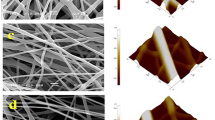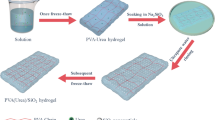Abstract
Porous three-dimensional (3D) scaffolds are promising treatment options in regenerative medicine. Supercritical and dense-phase fluid technologies provide an attractive alternative to solvent-based scaffold fabrication methods. In this work, we report on the fabrication of poly-etheresterurethane (PPDO-PCL) based porous scaffolds with tailorable pore size, porosity, and pore interconnectivity by using supercritical CO2 (scCO2) fluid-foaming. The influence of the processing parameters such as soaking time, soaking temperature and depressurization on porosity, pore size, and interconnectivity of the foams were investigated. The average pore diameter could be varied between 100-800 μm along with a porosity in the range from (19 ± 3 to 61 ± 6)% and interconnectivity of up to 82%. To demonstrate their applicability as scaffold materials, selected foams were sterilized via ethylene oxide sterilization. They showed negligible cytotoxicity in tests according to DIN EN ISO 10993-5 and 10993-12 using L929 cells. The study demonstrated that the pore size, porosity and the interconnectivity of this multi-phase semicrystalline polymer could be tailored by careful control of the processing parameters during the scCO2 foaming process. In this way, PPDO-PCL scaffolds with high porosity and interconnectivity are potential candidate materials for regenerative treatment options.
Similar content being viewed by others
References
X. W., Y. H. Qiao, Y. X. Chen, G. J. He and H. Lin, Polym Eng Sci 56 (9), 980–986 (2016).
V. Dolomanova, V. Kumar, R. Pyrz, L. A. O. Madaleno, L. R. Jensen and J. C. M. Rauhe, Cell Polym 31 (3), 125–143 (2012).
V. Dolomanova, V. Kumar, R. Pyrz, L. A. O. Madaleno, L. R. Jensen and J. C. M. Rauhe, Cell Polym 32 (1), 1–19 (2013).
T. Ellingham, L. Duddleston and L. S. Turng, Polymer 117, 132–139 (2017).
X. Q. Lan, W. T. Zhai and W. G. Zheng, Ind Eng Chem Res 52 (16), 5655–5665 (2013).
X. X. Wang, V. Kumar and W. Li, Cell Polym 31 (1), 1–18 (2012).
T. Weigel, G. Schinkel and A. Lendlein, Expert Rev Med Devic 3 (6), 835–851 (2006).
K. Luetzow, F. Klein, T. Weigel, R. Apostel, A. Weiss and A. Lendlein, J Biomech 40, S80–S88 (2007).
N. Goonoo, A. Bhaw-Luximon, G. L. Bowlin and D. Jhurry, Polym Int 62 (4), 523–533 (2013).
M. Grunlan, D. W. Zhang, M. Hahn, J. Erndt-Marino and A. Jimenez-Vergara, Abstr Pap Am Chem S 252 (2016).
J. Heitz, C. Plamadeala, M. Wiesbauer, P. Freudenthaler, R. Wollhofen, J. Jacak, T. A. Klar, B. Magnus, D. Kostner, A. Weth, W. Baumgartner and R. Marksteiner, J Biomed Mater Res A 105 (3), 891–899 (2017).
Y. H. Hu, S. R. Winn, I. Krajbich and J. O. Hollinger, J Biomed Mater Res A 64a (3), 583–590 (2003).
N. Iwasaki, Y. Kasahara, S. Yamane, T. Igarashi, A. Minami and S. Nisimura, Polymers-Basel 3 (1), 100–113 (2011).
A. Jaramillo-Botero, M. Blanco, Y. Y. Li, G. McGuinness and W. A. Goddard, J Comput Theor Nanos 7 (7), 1238–1256 (2010).
G. Y. Ji, W. T. Zhai, D. P. Lin, Q. Ren, W. G. Zheng and D. W. Jung, Ind Eng Chem Res 52 (19), 6390–6398 (2013).
G. Z. Jin, T. H. Kim, J. H. Kim, J. E. Won, S. Y. Yoo, S. J. Choi, J. K. Hyun and H. W. Kim, J Biomed Mater Res A 101 (5), 1283–1291 (2013).
Y. M. Ju, K. Park, J. S. Son, J. J. Kim, J. W. Rhie and D. K. Han, J Biomed Mater Res B 85b (1), 252–260 (2008).
H. Y. Mi, S. Palumbo, X. Jing, L. S. Turng, W. J. Li and X. F. Peng, J Biomed Mater Res B 102 (7), 1434–1444 (2014).
A. V. Nawaby, A. A. Farah, X. Liao, W. J. Pietro and M. Day, Biomacromolecules 6 (5), 2458–2461 (2005).
G. Pertici, F. Carinci, G. Carusi, D. Epistatus, T. Villa, F. Crivelli, F. Rossi and G. Perale, J Biol Reg Homeos Ag 29 (3), 136–148 (2015).
M. M. Rahman, M. Shahruzzaman, M. S. Islam, M. N. Khan and P. Haque, J Polym Eng 39 (2), 134–142 (2019).
P. Ros-Tarraga, A. Murciano, P. Mazon, S. A. Gehrke and P. N. De Aza, Ceram Int 43 (8), 6548–6553 (2017).
K. B. Ryan and D. J. Mooney, Tissue Eng Pt A 21, S108–S109 (2015).
A. Sadiasa, T. H. Nguyen and B. T. Lee, J Biomat Sci-Polym E 25 (2), 150–167 (2014).
J. San Roman, M. Martin, L. Rojo, R. Rosales and S. Deb, Tissue Eng Pt A 21, S59–S59 (2015).
C. Gualandi, L. J. White, L. Chen, R. A. Gross, K. M. Shakesheff, S. M. Howdle and M. Scandola, Acta Biomaterialia 6 (1), 130–136 (2010).
J. Albuerne, L. Marquez, A. J. Müller, J.-M. Raquez, P. Degée and P. Dubois, Macromolecular Chemistry and Physics 206 (9), 903–914 (2005).
Y. Brito, M. A. Sabino, G. Ronca and A. J. Müller, Journal of Applied Polymer Science 110 (6), 3848–3858 (2008).
I. A. Chaim, M. A. Sabino, M. Mendt, A. J. Müller and D. Ajami, Journal of Tissue Engineering and Regenerative Medicine 6 (4), 272–279 (2012).
A. Lendlein and R. Langer, Science 296 (5573), 1673–1676 (2002).
D. Rickert, M. O. Scheithauer, S. Coskun, S. Kelch, A. Lendlein and R. P. Franke, Clin Hemorheol Micro 36 (4), 301–311 (2007).
L. J. White, V. Hutter, H. Tai, S. M. Howdle and K. M. Shakesheff, Acta Biomaterialia 8 (1), 61–71 (2012).
C. X. Chen, Q. Q. Liu, X. Xin, Y. X. Guan and S. J. Yao, J Supercrit Fluid 117, 279–288 (2016).
M. Behl, U. Ridder, Y. Feng, S. Kelch and A. Lendlein, Soft Matter 5 (3), 676–684 (2009).
B. Hiebl, R. Fuhrmann, F. Jung, K. Kratz, A. Lendlein and R. P. Franke, Clin Hemorheol Micro 45 (2-4), 117–122 (2010).
J. Cui, K. Kratz, B. Hiebl, F. Jung and A. Lendlein, Tissue Eng Pt A 17 (3-4), 563–563 (2011).
M. Karimi, M. Heuchel, T. Weigel, M. Schossig, D. Hofmann and A. Lendlein, J Supercrit Fluid 61, 175–190 (2012).
S. K. Goel and E. J. Beckman, Polym Eng Sci 34 (14), 1137–1147 (1994).
M. A. Fanovich and P. Jaeger, Mat Sci Eng C-Mater 32 (4), 961–968 (2012).
Author information
Authors and Affiliations
Corresponding author
Rights and permissions
About this article
Cite this article
Behl, M., Razzaq, M.Y., Mazurek-Budzyńska, M. et al. Polyetheresterurethane Based Porous Scaffolds with Tailorable Architectures by Supercritical CO2 Foaming. MRS Advances 5, 2317–2330 (2020). https://doi.org/10.1557/adv.2020.345
Published:
Issue Date:
DOI: https://doi.org/10.1557/adv.2020.345




